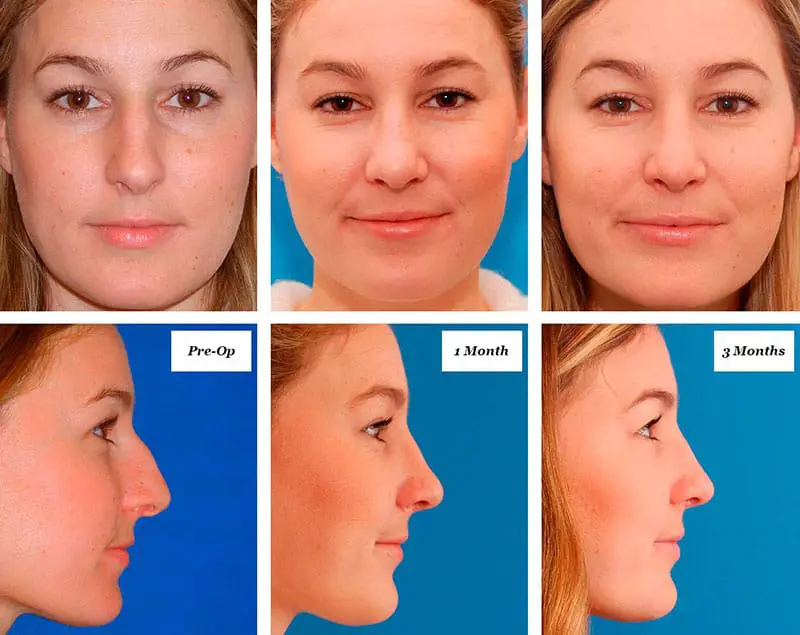
Most people get nose jobs to make their noses smaller. However, many people worry that the tips of their noses seem larger after rhinoplasty.
The tip of most people’s noses should become smaller after rhinoplasty. The skin and/or added cartilage in the nose, particularly on the nasal tip, tends to swell for a while until the healing process is complete.
Does The Nose Tip Shrink After Rhinoplasty?
The tip of your nose usually shrinks after you heal from rhinoplasty. Most noses will look far from final after surgery, but that is normal.
The nasal tip and bridge (depending on the surgery) often look larger right after surgery. Some people may even notice asymmetry in their noses.
It would be best if you waited for the healing process to finish before seeing the real size and shape of the tip of your nose.
Some reasons why the tip of your nose looks bigger after surgery include:
- Skin swelling
- Ear cartilage
But apart from that, obviously, the tip is not going to get smaller than when you started unless your surgeon actually wanted it that way.

Why Does My Nose Look Bigger After Rhinoplasty?
Skin Swelling
Some people worry that their nose looks bigger after surgery, which is obviously a concern if you got the procedure to make your nose smaller. However, having a larger-looking nose post-operation is entirely normal.
Most patients will experience a lot of swelling in their nose after surgery. Surgeons rarely remove or replace the nose’s skin.
Most surgeons will move the skin (depending on how the surgeon performed the procedure), reshape the bone and cartilage, then lay the skin back onto the nose.
Your nose will typically swell as it heals. Swelling tends to vary depending on how thick your skin is. The swelling tends to be very noticeable for the first two weeks after surgery.
Some people notice that 10-25% of the swelling goes away after three weeks. You can expect about 25-40% of it to settle down at six weeks.
Most people will need to wait one year for a significant decrease in swelling. However, people who need revisions or have thicker skin may need to wait a year and a half or longer.
As for the tip of the nose, that part may take the longest to decrease in swelling. The skin of your nasal tip tends to be thicker than the rest of your nose, so it can take longer to contract.
Many people often worry about the size of their nasal tip for a few months after surgery. Try to take a photo of your nose after surgery so you can compare it to your nose in the future. That way, it will be easy to monitor if it is getting smaller.
For instance, take a look at this person’s progress:

The photo on the left shows his nose four weeks after surgery. The nasal tip is clearly huge and broad. However, the swelling significantly reduced after four months to reveal a slimmer, smaller nasal tip.
Keep in mind that people heal differently, so the time your nose shrinks may vary. You can always ask your surgeon to check on your healing progress if you have any worries.
Ear Cartilage
Similar to your skin, cartilage can take some time to shrink. Some surgeons use ear cartilage to reshape the nose and add tissue (if you want a more prominent, shapelier nose), but the initial result may look larger than the patient’s goals at first.

The newly-constructed cartilage needs time to settle down on your nose. Like the skin on your nose, it may take 6-12 months to see the final result of your rhinoplasty once the cartilage settles.
How the Nasal Tip Can Determine if You Should Get a Nose Job
As stated earlier, the skin on the tip of your nose tends to be thicker than the rest. However, some people have a much thicker skin in that area compared to other people.
Some surgeons may not want to perform rhinoplasty (or suggest an alternative) if you have extremely thick skin on the nasal tip. People with thick skin on the nasal tip may not be happy with their rhinoplasty results, especially if they want a smaller nose.
Other than cartilage, the skin is crucial to a successful nose job. Most surgeons agree that you cannot change the skin.
If a patient has extremely thick skin on the nasal tip, a surgeon may not want to perform rhinoplasty. The nasal tip will still look large (because you cannot change the skin) after surgery, no matter what you do to the cartilage (Taylor et al., 2010).
Therefore, the nasal tip would look larger after surgery, throwing off the nose’s proportions. On the other hand, surgeons need to smooth out any irregularities more for patients with very thin skin to avoid apparent bumps.

